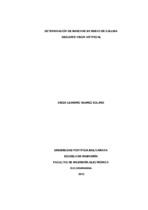| dc.contributor.advisor | Silva, Luis Ángel | |
| dc.contributor.author | Suárez Solano, Diego Leandro | |
| dc.coverage.temporal | 2013 | |
| dc.date.accessioned | 2020-03-13T20:46:27Z | |
| dc.date.available | 2020-03-13T20:46:27Z | |
| dc.date.issued | 2013 | |
| dc.identifier.uri | http://hdl.handle.net/20.500.11912/5094 | |
| dc.description | 108 páginas | spa |
| dc.description.abstract | La visión artificial está incursionando cada vez más en la industria alimenticia y es
empleada en tareas de clasificación y control de calidad de forma eficiente, acertada y homogénea. En este proyecto se presenta el diseño de un sistema de visón artificial aplicado a la clasificación de huevo de gallina según el tamaño y el porcentaje de suciedad de la superficie.
Inicialmente se adquirieron 270 imágenes de tres cubetas de huevos, dos de ellas,
huevos de revoltura producidos en granjas y la cubeta restante con huevos clasificados en las seis presentaciones comerciales para Colombia: Jumbo, AAA, AA, A, B y C. Se utilizó una cámara CCD para captar las imágenes de los huevos, en formato JPG y en el espacio de color RGB. Cada imagen fue transformada al espacio de color YCrCb, espacio de color que presentó las mejores características para el proceso de segmentación. Se
tomó la componente Cr para realizar la segmentación por umbralizacion empleando el método de Otsu. A la imagen binaria resultante, se le aplicaron operaciones morfológicas con el fin de facilitar el procesamiento posterior. Las características extraídas fueron: área,
perímetro, redondez, y los radios de la elipse descrita por la forma del huevo, así como, el área de la suciedad presente en cada huevo. Para el proceso de clasificación se implementan dos métodos: el método de ajuste por regresión lineal y el método de
agrupación K-MEANS. Mediante el método de regresión lineal se obtiene un error superior al 10% con la necesidad de reajustar continuamente el clasificador. | spa |
| dc.description.abstract | Artificial vision is increasing their participation in the food industry and is used in sorting and quality control an efficient, accurate and consistent.`This project presents the design of an artificial vision system applied to chicken egg sorting according to size and percentage of surface dirt.
Initially were acquired 270 images of three eggs trays, two of them, dirty egg produced in farms and the remaining tray with graded eggs in the six commercial presentations for Colombia: Jumbo, AAA, AA, A, B y C.A CCD camera was used to capture images of the eggs, in JPG format and in the RGB color space. Each image was converted to YCrCb color space, color space that presented the best features for the segmentation process.
Was taken the Cr component for thresholding segmentation using the Otsu method. The resulting binary image, was subjected to morphological operations to facilitate subsequent
processing.The features extracted were: area, circumference, roundness, and the radii of the ellipse described by the shape of the egg, and the area of the dirt present in each egg.
For the classification process were implemented two methods: the method of adjustment by linear regression and clustering method K-Means.By linear regression method obtains an error greater than 10% with the need to continually adjust the classifier. | eng |
| dc.format.mimetype | application/pdf | |
| dc.language.iso | spa | |
| dc.publisher | Universidad Pontificia Bolivariana | spa |
| dc.rights | Attribution-NonCommercial-NoDerivatives 4.0 International | * |
| dc.rights.uri | http://creativecommons.org/licenses/by-nc-nd/4.0/ | * |
| dc.subject | Visión artificial | spa |
| dc.subject | Huevos - Inspección | spa |
| dc.subject | Control de calidad | spa |
| dc.subject | Cámaras de vídeo | spa |
| dc.subject | Algoritmos | spa |
| dc.title | Determinación de manchas de huevos de gallina mediante visión artificial | spa |
| dc.type | Trabajo de grado | spa |
| dc.publisher.department | Escuela de Ingenierías | spa |
| dc.publisher.program | Ingeniería Electrónica | spa |
| dc.type.hasVersion | publishedVersion | spa |
| dc.description.sectional | Bucaramanga | spa |
| dc.description.degreename | Ingeniero Electrónico | spa |


